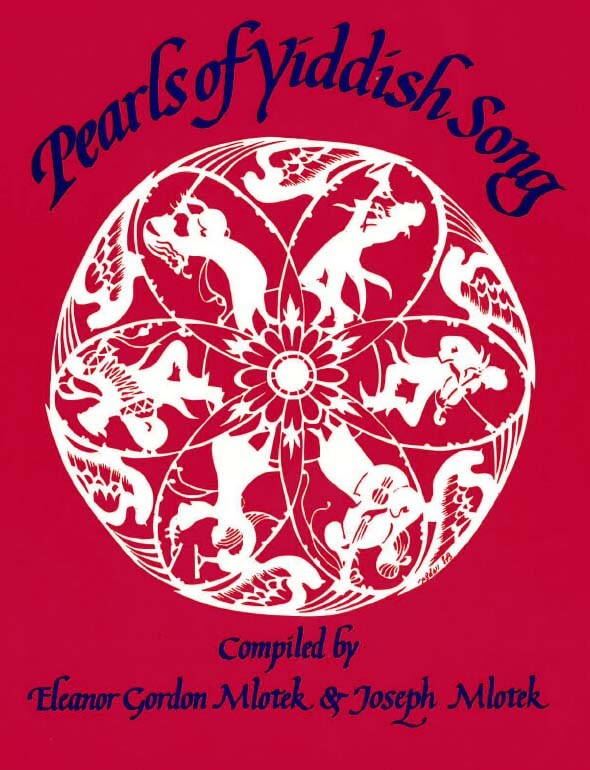Song by folk poet Mark Markovich Warshawsky (1840-1907), author and composer of many popular Yiddish songs like “Oyfn pripetshik” (At the fireplace), “Di mizinke oysgegebn” (The youngest daughter’s wedding). This melody was later used for Yosl Kotler’s song “Simkhe mit zayn yidene” (Simkhe and his wife). A second melody was published in 1928 in 90 geklibene yidishe folkslider and recorded by such contemporary singers as Theodore Bikel and Martha Shlamme. On the record Songs of Freedom and Resistance, Zalmen Mlotek combines the two melodies, both of which are presented here. The song is traditionally sung at the Workmen’s Circle annual Third Seder in New York.

Dear Malke,
May you be well!
Fill up the goblet,
The goblet with wine.
Bim-bam-bam, bim-bam!
From this goblet,
Which gleams so prettily,
My grandfather would drink
My grandfather himself.
There have been bad times,
As sometimes happen,
But I held on to the goblet
With iron and steel.
It would amuse all the children,
As you know.
From my father the goblet
Passed to me.
Dear Malke,
May you be well!
For whom shall I drink this wine?
I drink for the little spark of Jewishness
That struggles and never tires.
I drink to life without end
I want to drink for those who departed.
I drink for my enemies,
But don’t reveal it.
Look, tears are spurting
From the goblet.
Sing louder and louder:
God, You are great!
Malke, put away the goblet.
The song is ended.
Tayere Malke —
Gezunt zolstu zayn!
Gis on dem bekher,
Dem bekher mit vayn.
Bim-bam-bam, bim-bam!
Fun dem dozikn bekher,
Er glantst azoy sheyn,
Hot getrunken mayn zeyde,
Mayn zeyde aleyn.
Geven shlekhte tsaytn,
Vi es makht zikh a mol
Nor dem bekher hob ikh gehaltn —
Ayzn un shtol;
Er hot mesameyekh geven ale kinder
Bekant is dos dir,
Funem tatn iz der bekher
Gekumen tsu mir!
Tayere Malke,
Gezunt zolstu zayn!
Far vemen zol ikh trinken
Dem dozikn vayn?
Lekhayim vil ikh trinken
Far dem pintele yid,
Vos mutshet zikh tomid
Un vert keyn mol nit mid!
Lekhayim vil ikh trinken,
Un take on an ek,
Far di vos zaynen geforn
Oyf eybik avek!
Kh’trink far mayne sonim
Nor zog zey nit oys!
Kuk, trern zey shpritsn
Fun bekher aroys!
Zingt hekher un hekher:
Got, du bist groys!
Bahalt, Malke, dem bekher,
Dos lidl iz oys.
טײַערע מלכּה —
געזונט זאָלסטו זײַן!
גיס אָן דעם בעכער,
דעם בעכער מיט װײַן.
בים־באַם־באַם, בים־באַם!
פֿון דעם דאָזיקן בעכער,
ער גלאַנצט אַזױ שײן,
האָט געטרונקען מײַן זײדע,
מײַן זײדע אַלײן.
געװען שלעכטע צײַטן,
װי עס מאַכט זיך אַ מאָל,
נאָר דעם בעכער האָב איך געהאַלטן —
אײַזן און שטאָל!
ער האָט משׂמח געװען אַלע קינדער,
באַקאַנט איז דאָס דיר,
פֿונעם טאַטן איז דער בעכער
געקומען צו מיר!
טײַערע מלכּה,
געזונט זאָלסטו זײַן!
פֿאַר װעמען זאָל איך טרינקען
דעם דאָזיקן װײַן?
לחײם װיל איך טרינקען
פֿאַר דעם פּינטעלע ייִד,
װאָס מוטשעט זיך תּמיד
און װערט קײן מאָל ניט מיד!
לחײם װיל איך טרינקען,
און טאַקע אָן אַן עק,
פֿאַר די װאָס זײַנען געפֿאָרן
אױף אײביק אַװעק!
כ’טרינק פֿאַר מײַנע שׂונאים,
נאָר זאָג זײ ניט אױס!
קוק, טרערן זײ שפּריצן
פֿון בעכער אַרױס!
זינגט העכער און העכער:
גאָט, דו ביסט גרױס!
באַהאַלט, מלכּה, דעם בעכער,
דאָס לידל איז אױס.
Song Title: Tayere Malke

First published in 1988 as Pearls of Yiddish Song: Favorite Folk, Art and Theatre Songs, this anthology contains 115 songs. Some material had never been published, while others, included in rare song collections or sheet music, were largely inaccessible. The songs presented reflect Jewish life in Eastern Europe and the United States and depict childhood, love, family celebrations, poverty, work and struggle. There are also songs from the Hasidic and Maskilic movements, songs of Zion and of America, as well as songs from the Yiddish theater.
The title of this anthology derives from the weekly two-page feature column “Pearls of Yiddish Poetry,” which the compilers Yosl and Chana Mlotek initiated in 1970 in the Yiddish newspaper Der Forvertz (the Yiddish Daily Forward). Hundreds of readers from around the world — including authors, composers, singers, actors — became co-participants in this collective folk project and recalled melodies, lines, fragments, stanzas and their variants of songs, poems, and plays which they had heard in their youth. At first, readers sent in only written material. Later, they also taped songs on cassettes, many of whose melodies had, until then, never been recorded. They also identified and supplied missing information regarding lyricists, poets, and composers and described the circumstances surrounding the songs’ origins, their dissemination, diffusion and impact.